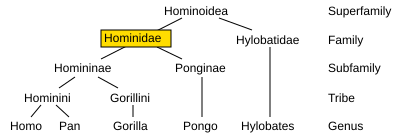User:MartinZ/sandbox/Human
| Human Ma Middle Pleistocene – Recent
| |
|---|---|
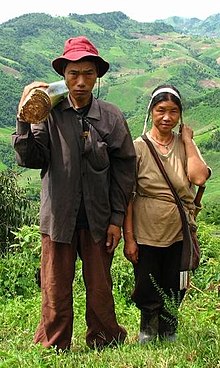
| |
| An adult human male (left) and female (right) from Thailand | |
| Scientific classification | |
| Domain: | Eukaryota |
| Kingdom: | Animalia |
| Phylum: | Chordata |
| Class: | Mammalia |
| Order: | Primates |
| Suborder: | Haplorhini |
| Infraorder: | Simiiformes |
| Family: | Hominidae |
| Subfamily: | Homininae |
| Tribe: | Hominini |
| Genus: | Homo |
| Species: | H. sapiens
|
| Binomial name | |
| Homo sapiens Linnaeus, 1758
| |
| Subspecies | |
|
Homo sapiens idaltu White et al., 2003Homo sapiens sapiens
| |

| |
| Homo sapiens population density | |
| Synonyms | |
|
Species synonymy[1]
| |
Modern humans (
Early hominins—particularly the
The spread of humans and
Humans are uniquely adept at utilizing systems of symbolic communication (such as language and art) for self-expression and the exchange of ideas, and for organizing themselves into purposeful groups. Humans create complex
Though most of human existence has been sustained by hunting and gathering in band societies,[10] increasing numbers of human societies began to practice sedentary agriculture approximately some 10,000 years ago,[11] domesticating plants and animals, thus allowing for the growth of civilization. These human societies subsequently expanded in size, establishing various forms of government, religion, and culture around the world, unifying people within regions to form states and empires. The rapid advancement of scientific and medical understanding in the 19th and 20th centuries led to the development of fuel-driven technologies and increased lifespans, causing the human population to rise exponentially. By 2014, the global human population was estimated to be around 7.2 billion and rising.[12][13] By February 2016, the United States Census Bureau had estimated that the world population had exceeded 7.3 billion.[14]
Etymology and definition
million years ago) |
In common usage, the word "human" generally refers to the only extant species of the genus Homo — anatomically and behaviorally modern Homo sapiens. Its usage often designates differences between that species as a whole and any other group or entity.[citation needed]
In scientific terms, the meanings of "
The English adjective human is a
]The species
History
Evolution and range
The genus
Evidence from molecular biology
The closest living relatives of humans are chimpanzees (genus
Evidence from the fossil record
There is little fossil evidence for the divergence of the gorilla, chimpanzee and hominin lineages.
The earliest members of the genus Homo are
Anatomical adaptations
Human evolution is characterized by a number of
The human species developed a much larger brain than that of other primates – typically 1,330
The reduced degree of sexual dimorphism is primarily visible in the reduction of the male
Rise of Homo sapiens
By the beginning of the
This dispersal out of Africa is estimated to have begun about 70,000 years BP from Northeast Africa. Current evidence suggests that there was only one such dispersal and that it only involved a few hundred individuals. The vast majority of humans stayed in Africa and adapted to a diverse array of environments.[55] Modern humans subsequently spread globally, replacing earlier hominins (either through competition or hybridization). They inhabited Eurasia and Oceania by 40,000 years BP, and the Americas at least 14,500 years BP.[56][57]
Transition to civilization
The examples and perspective in this section may not represent a worldwide view of the subject. (May 2015) |
Until c. 10,000 years ago, humans lived as
The more complex human societies, called the first
The
With the advent of the Information Age at the end of the 20th century, modern humans live in a world that has become increasingly globalized and interconnected. As of 2010, almost 2 billion humans are able to communicate with each other via the Internet,[62] and 3.3 billion by mobile phone subscriptions.[63]
Although interconnection between humans has encouraged the growth of
Habitat and population

Early human settlements were dependent on proximity to
Technology has allowed humans to colonize all of the continents and adapt to virtually all climates. Within the last century, humans have explored Antarctica, the ocean depths, and outer space, although large-scale colonization of these environments is not yet feasible. With a population of over seven billion, humans are among the most numerous of the large mammals. Most humans (61%) live in Asia. The remainder live in the Americas (14%), Africa (14%), Europe (11%), and Oceania (0.5%).[citation needed]
Human habitation within closed ecological systems in hostile environments, such as Antarctica and outer space, is expensive, typically limited in duration, and restricted to scientific, military, or industrial expeditions. Life in space has been very sporadic, with no more than thirteen humans in space at any given time.[66] Between 1969 and 1972, two humans at a time spent brief intervals on the Moon. As of April 2024, no other celestial body has been visited by humans, although there has been a continuous human presence in space since the launch of the initial crew to inhabit the International Space Station on October 31, 2000.[67] However, other celestial bodies have been visited by human-made objects.[68][69][70]
Since 1800, the human population has increased from one billion[71] to over seven billion,[72] In 2004, some 2.5 billion out of 6.3 billion people (39.7%) lived in urban areas. In February 2008, the U.N. estimated that half the world's population would live in urban areas by the end of the year.[73] Problems for humans living in cities include various forms of pollution and crime,[74] especially in inner city and suburban slums. Both overall population numbers and the proportion residing in cities are expected to increase significantly in the coming decades.[75]
Humans have had a dramatic effect on the
Biology
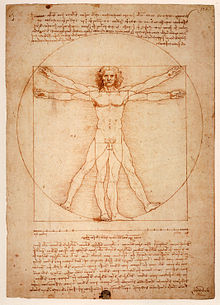
Anatomy and physiology
Most aspects of human physiology are closely
Humans, like most of the other
As a consequence of bipedalism, human females have narrower
Apart from bipedalism, humans differ from chimpanzees mostly in
It is estimated that the worldwide average
Although humans appear hairless compared to other primates, with notable hair growth occurring chiefly on the top of the head, underarms and pubic area, the average human has more hair follicles on his or her body than the average chimpanzee. The main distinction is that human hairs are shorter, finer, and less heavily pigmented than the average chimpanzee's, thus making them harder to see.[90] Humans have about 2 million sweat glands spread over their entire bodies, many more than chimpanzees, whose sweat glands are scarce and are mainly located on the palm of the hand and on the soles of the feet.[91]
The
Genetics

Like all mammals, humans are a diploid eukaryotic species. Each somatic cell has two sets of 23 chromosomes, each set received from one parent; gametes have only one set of chromosomes, which is a mixture of the two parental sets. Among the 23 pairs of chromosomes there are 22 pairs of autosomes and one pair of sex chromosomes. Like other mammals, humans have an XY sex-determination system, so that females have the sex chromosomes XX and males have XY.[93]
One
By comparing the parts of the genome that are not under natural selection and which therefore accumulate mutations at a fairly steady rate, it is possible to reconstruct a genetic tree incorporating the entire human species since the last shared ancestor. Each time a certain mutation (SNP) appears in an individual and is passed on to his or her descendants, a
Human accelerated regions, first described in August 2006,[102][103] are a set of 49 segments of the human genome that are conserved throughout vertebrate evolution but are strikingly different in humans. They are named according to their degree of difference between humans and their nearest animal relative (chimpanzees) (HAR1 showing the largest degree of human-chimpanzee differences). Found by scanning through genomic databases of multiple species, some of these highly mutated areas may contribute to human-specific traits.[citation needed]
The forces of natural selection have continued to operate on human populations, with evidence that certain regions of the genome display directional selection in the past 15,000 years.[104]
Life cycle
As with other mammals,
The zygote divides inside the female's uterus to become an embryo, which over a period of 38 weeks (9 months) of gestation becomes a fetus. After this span of time, the fully grown fetus is birthed from the woman's body and breathes independently as an infant for the first time. At this point, most modern cultures recognize the baby as a person entitled to the full protection of the law, though some jurisdictions extend various levels of personhood earlier to human fetuses while they remain in the uterus.
Compared with other species, human childbirth is dangerous. Painful labors lasting 24 hours or more are not uncommon and sometimes lead to the death of the mother, the child or both.
In developed countries, infants are typically 3–4 kg (6–9 pounds) in weight and 50–60 cm (20–24 inches) in height at birth.
For various reasons, including biological/genetic causes,
Diet

Humans are
Until the development of agriculture approximately 10,000 years ago, Homo sapiens employed a hunter-gatherer method as their sole means of food collection. This involved combining stationary food sources (such as fruits, grains, tubers, and mushrooms, insect larvae and aquatic mollusks) with
In general, humans can survive for two to eight weeks without food, depending on stored body fat. Survival without water is usually limited to three or four days. About 36 million humans die every year from causes directly or indirectly related to hunger.
Biological variation


No two humans – not even
Most current
The human body's ability to
There is biological variation in the human species — with traits such as
The hue of human skin and hair is determined by the presence of
Structure of variation


Within the human species, the greatest degree of genetic
Males typically have larger
Humans of the same sex are 99.9% genetically identical. There is extremely little variation between human geographical populations, and most of the variation that does occur is at the personal level within local areas, and not between populations.[140][171][172] Of the 0.1% of human genetic differentiation, 85% exists within any randomly chosen local population, be they Italians, Koreans, or Kurds. Two randomly chosen Koreans may be genetically as different as a Korean and an Italian. Any ethnic group contains 85% of the human genetic diversity of the world. Genetic data shows that no matter how population groups are defined, two people from the same population group are about as different from each other as two people from any two different population groups.[140][173][174][175]
Current genetic research has demonstrated that humans on the
Geographical distribution of human variation is complex and constantly shifts through time which reflects complicated human evolutionary history. Most human biological variation is clinally distributed and blends gradually from one area to the next. Groups of people around the world have different frequencies of polymorphic genes. Furthermore, different traits are non-concordant and each have different clinal distribution. Adaptability varies both from person to person and from population to population. The most efficient adaptive responses are found in geographical populations where the environmental stimuli are the strongest (e.g. Tibetans are highly adapted to high altitudes). The clinal geographic genetic variation is further complicated by the migration and mixing between human populations which has been occurring since prehistoric times.[140][179][180][181][182][183]
Human variation is highly non-concordant: most of the genes do not cluster together and are not inherited together. Skin and hair color are not correlated to height, weight, or athletic ability. Human species do not share the same patterns of variation through geography. Skin color varies with latitude and certain people are tall or have brown hair. There is a statistical correlation between particular features in a population, but different features are not expressed or inherited together. Thus, genes which code for superficial physical traits – such as skin color, hair color, or height – represent a minuscule and insignificant portion of the human genome and do not correlate with genetic affinity. Dark-skinned populations that are found in Africa, Australia, and South Asia are not closely related to each other.
Due to practices of group
Psychology
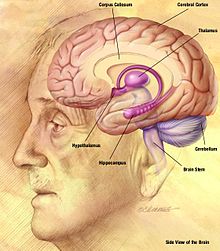
The human brain, the focal point of the
Generally regarded as more capable of these higher order activities, the human brain is believed to be more "intelligent" in general than that of any other known species. While some non-human species are capable of creating structures and
Sleep and dreaming
Humans are generally
Consciousness and thought
Humans are one of the relatively few species to have sufficient self-awareness to recognize themselves in a mirror.[202] Already at 18 months, most human children are aware that the mirror image is not another person.[203]

The human brain
The physical aspects of the mind and brain, and by extension of the nervous system, are studied in the field of neurology, the more behavioral in the field of psychology, and a sometimes loosely defined area between in the field of psychiatry, which treats mental illness and behavioral disorders. Psychology does not necessarily refer to the brain or nervous system, and can be framed purely in terms of phenomenological or information processing theories of the mind. Increasingly, however, an understanding of brain functions is being included in psychological theory and practice, particularly in areas such as artificial intelligence, neuropsychology, and cognitive neuroscience.
The nature of thought is central to psychology and related fields.
Some philosophers divide consciousness into phenomenal consciousness, which is experience itself, and access consciousness, which is the processing of the things in experience.
Motivation and emotion
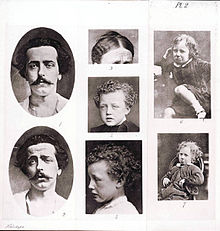
Motivation is the driving force of desire behind all deliberate
influences. .Emotion has a significant influence on, or can even be said to control, human behavior, though historically many
In modern scientific thought, certain refined emotions are considered a complex neural trait innate in a variety of
Sexuality and love

For humans, sexuality has important social functions: it creates physical intimacy, bonds and hierarchies among individuals, besides ensuring biological
Human choices in acting on sexuality are commonly influenced by cultural norms which vary widely. Restrictions are often determined by religious beliefs or social customs. The pioneering researcher
Behavior
| Human society statistics | |
|---|---|
| World population | 8.1 billion |
| Population density [citation needed] |
12.7 per km² (4.9 mi²) by total area 43.6 per km² (16.8 mi²) by land area |
Largest agglomerations ]
[citation needed |
Beijing, Bogotá, Buenos Aires, Cairo, Delhi, Dhaka, Guangzhou, Istanbul, Jakarta, Karachi, Kinshasa, Kolkata, Lagos, Lima, London, Los Angeles, Manila, Mexico City, Moscow, Mumbai, New York City, Osaka, Paris, Rio de Janeiro, São Paulo, Seoul, Shanghai, Shenzhen, Tehran, Tianjin, Tokyo, Wuhan |
| Most widely spoken native languages[209] | Oriya
|
| Most popular religions[210] | Baha'i
|
| GDP (nominal) [citation needed] |
$36,356,240 million USD )
($5,797 USD per capita |
| GDP (PPP) [citation needed] |
$51,656,251 million IND ($8,236 per capita) |

Humans are highly social beings and tend to live in large complex social groups. More than any other creature, humans are capable of utilizing systems of
Culture is defined here as patterns of complex symbolic behavior, i.e. all behavior that is not innate but which has to be learned through social interaction with others; such as the use of distinctive
Language
While many species communicate, language is unique to humans, a defining feature of humanity, and a cultural universal. Unlike the limited systems of other animals, human language is open – an infinite number of meanings can be produced by combining a limited number of symbols. Human language also has the capacity of displacement, using words to represent things and happenings that are not presently or locally occurring, but reside in the shared imagination of interlocutors.[92] Language differs from other forms of communication in that it is modality independent; the same meanings can be conveyed through different media, auditively in speech, visually by sign language or writing, and even through tactile media such as braille. Language is central to the communication between humans, and to the sense of identity that unites nations, cultures and ethnic groups. The invention of writing systems at least five thousand years ago allowed the preservation of language on material objects, and was a major technological advancement. The science of linguistics describes the structure and function of language and the relationship between languages. There are approximately six thousand different languages currently in use, including sign languages, and many thousands more that are extinct.[211]
Gender roles
The sexual division of humans into male and female has been marked culturally by a corresponding division of roles, norms,
Kinship
All human societies organize, recognize and classify types of social relationships based on relations between parents and children (
Ethnicity
Humans often form ethnic groups, such groups tend to be larger than kinship networks and be organized around a common identity defined variously in terms of shared ancestry and history, shared cultural norms and language, or shared biological phenotype. Such ideologies of shared characteristics are often perpetuated in the form of powerful, compelling narratives that give legitimacy and continuity to the set of shared values. Ethnic groupings often correspond to some level of political organization such as the
Society, government, and politics
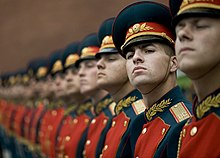
Society is the system of organizations and institutions arising from interaction between humans. A state is an organized political community occupying a definite territory, having an organized government, and possessing internal and external sovereignty. Recognition of the state's claim to independence by other states, enabling it to enter into international agreements, is often important to the establishment of its statehood. The "state" can also be defined in terms of domestic conditions, specifically, as conceptualized by Max Weber, "a state is a human community that (successfully) claims the monopoly of the 'legitimate' use of physical force within a given territory."[218]
Government can be defined as the political means of creating and enforcing laws; typically via a bureaucratic hierarchy. Politics is the process by which decisions are made within groups; this process often involves conflict as well as compromise. Although the term is generally applied to behavior within governments, politics is also observed in all human group interactions, including corporate, academic, and religious institutions. Many different political systems exist, as do many different ways of understanding them, and many definitions overlap. Examples of governments include monarchy, Communist state, military dictatorship, theocracy, and liberal democracy, the last of which is considered dominant today. All of these issues have a direct relationship with economics.
Trade and economics
Trade is the voluntary exchange of goods and services, and is a form of economics. A mechanism that allows trade is called a
Economics is a social science which studies the production, distribution, trade, and consumption of goods and services. Economics focuses on measurable variables, and is broadly divided into two main branches: microeconomics, which deals with individual agents, such as households and businesses, and macroeconomics, which considers the economy as a whole, in which case it considers aggregate supply and demand for money, capital and commodities. Aspects receiving particular attention in economics are resource allocation, production, distribution, trade, and competition. Economic logic is increasingly applied to any problem that involves choice under scarcity or determining economic value.
War


War is a state of organized armed conflict between
There have been a wide variety of
Material culture and technology
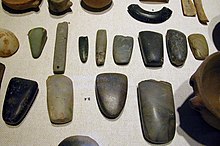
Stone tools were used by proto-humans at least 2.5 million years ago.[220] The controlled use of fire began around 1.5 million years ago. Since then, humans have made major advances, developing complex technology to create tools to aid their lives and allowing for other advancements in culture. Major leaps in technology include the discovery of agriculture – what is known as the Neolithic Revolution, and the invention of automated machines in the Industrial Revolution.
Body culture
Throughout history, humans have altered their appearance by wearing clothing[221][222] and adornments, by trimming or shaving hair or by means of body modifications.
Body modification is the deliberate altering of the
Religion and spirituality
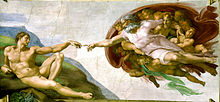

Religion is generally defined as a
Although the exact level of religiosity can be hard to measure,
Philosophy and self-reflection

Philosophy is a discipline or field of study involving the investigation, analysis, and development of ideas at a general, abstract, or fundamental level. It is the discipline searching for a general understanding of reality, reasoning and values. Major fields of philosophy include logic, metaphysics, epistemology, philosophy of mind, and axiology (which includes ethics and aesthetics). Philosophy covers a very wide range of approaches, and is used to refer to a worldview, to a perspective on an issue, or to the positions argued for by a particular philosopher or school of philosophy.
Science
Another unique aspect of human culture and thought is the development of complex methods for acquiring knowledge through observation, quantification, and verification. The scientific method has been developed to acquire knowledge of the physical world and the rules, processes and principles of which it consists, and combined with mathematics it enables the prediction of complex patterns of causality and consequence. Some other animals are able to recognize differences in small quantities, [citation needed] but humans are able to understand and recognize much larger, even abstract, quantities, and to recognize and understand algorithmic patterns which enables infinite counting routines and algebra, something that is not found in any other species.
Art, music, and literature
Music is a natural
See also
References
- ^ OCLC 62265494.
- ^ "Homo sapiens". IUCN Red List of Threatened Species. 2013.2. 2008. 2008.
{{cite journal}}:|access-date=requires|url=(help); Unknown parameter|assessors=ignored (help) - S2CID 2112935.)
{{cite journal}}: CS1 maint: multiple names: authors list (link - ^ "Hominidae Classification". Animal Diversity Web @ UMich. Retrieved 2006-09-25.
- .
- doi:10.1146/annurev.anthro.33.070203.144024.)
{{cite journal}}: CS1 maint: multiple names: authors list (link - .
- ISBN 978-0-674-03175-3.
- ISBN 9780521179447
- ^ "Hunting and gathering culture". Encyclopædia Britannica (online). Encyclopædia Britannica Inc., 2016.
- ^ "Neolithic." Ancient History Encyclopedia. Ancient History Encyclopedia Limited. 2014.
- ^ "World Population Clock". Census.gov. United States Census Bureau, Population Division. Retrieved 2012-09-15.
- ^ Roberts, Sam (31 October 2011). "U.N. Reports 7 Billion Humans, but Others Don't Count on It". The New York Times. Retrieved 2011-11-07.
- ^ "World Population Clock". Census.gov. United States Census Bureau, Population Division. Retrieved 2016-02-26.
- s.v."human."
- OEDconsiders obsolete the sense "a designation applied equally to particular individuals of either sex," citing a 1597 source as the most recent ("The Lord had but one paire of men in Paradise.") while it continues to endorse the sense "as a general or indefinite designation" as current in English.
- JSTOR 4065043.
- Porkorny (1959) s.v. "g'hðem" pp. 414–416; "Homo." Dictionary.com Unabridged (v 1.1). Random House, Inc. 23 September 2008. "Homo". Dictionary.com.
- ^ "Homo sapiens Etymology". Online Etymology Dictionary. Retrieved 25 July 2015.
- S2CID 20296624. Retrieved 2011-05-01.
- ^ Paul Rincon Humans 'left Africa much earlier' BBC News, 27 January 2011
- ^ Lowe, David J. (2008). "Polynesian settlement of New Zealand and the impacts of volcanism on early Maori society: an update" (PDF). University of Waikato. Retrieved 29 April 2010.
- S2CID 3551742.
- ^ PMID 10999270.)
{{cite journal}}: CS1 maint: multiple names: authors list (link - ^ Ajit, Varki and David L. Nelson. 2007. Genomic Comparisons of Humans and Chimpanzees. Annu. Rev. Anthropol. 2007. 36:191–209: "Sequence differences from the human genome were confirmed to be ∼1% in areas that can be precisely aligned, representing ∼35 million single base-pair differences. Some 45 million nucleotides of insertions and deletions unique to each lineage were also discovered, making the actual difference between the two genomes ∼4%."
- ^ Ken Sayers, Mary Ann Raghanti, and C. Owen Lovejoy. 2012 (forthcoming, october) Human Evolution and the Chimpanzee Referential Doctrine. Annual Review of Anthropology, Vol. 41
- ^ Ruvolo, M. 1997. Genetic Diversity in Hominoid Primates. Annual Review of Anthropology , Vol. 26, (1997), pp. 515–540
- PMID 9066793.
- ^ Human Chromosome 2 is a fusion of two ancestral chromosomes by Alec MacAndrew; accessed 18 May 2006.
- ^ Evidence of Common Ancestry: Human Chromosome 2 (video) 2007
- ^ Begun, David R. 2010. Miocene Hominids and the Origins of the African Apes and Humans. Annual Review of Anthropology, Vol. 39: 67 -84
- S2CID 22792031.)
{{cite journal}}: CS1 maint: multiple names: authors list (link - ^ "'First human' discovered in Ethiopia". BBC News.
- S2CID 4432091.
- ISSN 0047-2484.
- ISBN 0-393-97854-0.)
{{cite book}}: CS1 maint: multiple names: authors list (link - ISBN 9780804717465.)
{{cite journal}}: CS1 maint: multiple names: authors list (link - S2CID 1316969.)
{{cite journal}}: CS1 maint: multiple names: authors list (link - ^ .
- ^ Homo neanderthalensis - H. neanderthalensis is a widely known but poorly understood hominid ancestor. Archaeologyinfo.com. Retrieved on 2014-05-24.
- S2CID 19610624.)
{{cite journal}}: CS1 maint: multiple names: authors list (link - S2CID 16163137. Archived from the original(PDF) on 2013-05-24. Retrieved 2014-01-08.
- .
- PMID 17439362.)
{{cite journal}}: CS1 maint: multiple names: authors list (link - ^ "06.14.99 – Meat-eating was essential for human evolution, says UC Berkeley anthropologist specializing in diet". Berkeley.edu. 1999-06-14. Retrieved 2012-01-31.
- ^ "Meat in the human diet: an anthropological perspective. – Free Online Library". Thefreelibrary.com. 2007-09-01. Retrieved 2012-01-31.
- PNAS. Retrieved 17 April 2012.
- .
- PMID 21357228.
- ISBN 978-1-4020-9979-3.)
{{cite book}}:|editor-last=has generic name (help)CS1 maint: multiple names: editors list (link - S2CID 4320406.
- PMID 21944045.
- S2CID 2746487.)
{{cite journal}}: CS1 maint: multiple names: authors list (link - ^ Zimmer, Carl (17 March 2016). "Humans Interbred With Hominins on Multiple Occasions, Study Finds". The New York Times. Retrieved 17 March 2016.
- PMID 1840702.
- ^ Wolman, David (April 3, 2008). "Fossil Feces Is Earliest Evidence of N. America Humans". news.nationalgeographic.com.
{{cite journal}}: Cite journal requires|journal=(help) - S2CID 221464189.
- ISBN 978-1285661537. Retrieved 11 July 2015.)
{{cite book}}: CS1 maint: multiple names: authors list (link - ISBN 9781285982991. Retrieved 11 July 2015.
- ISBN 1-893554-57-0.
- ISBN 978-0-7432-4379-7.
- ^ "Internet Usage Statistics – The Internet Big Picture". internetworldstats.com/. Retrieved 19 November 2010.
- ^ "Reuters homepage". Reuters. Archived from the original on 2008-12-17. Retrieved 19 November 2010.
- S2CID 36156087.)
{{cite journal}}: CS1 maint: multiple names: authors list (link - PMID 16553315.
- ^ Nancy Atkinson (2009-03-26). "Soyuz Rockets to Space; 13 Humans Now in Orbit". Universetoday.com. Retrieved 2011-12-10.
- ^ Kraft, Rachel (December 11, 2010). "JSC celebrates ten years of continuous human presence aboard the International Space Station". JSC Features. Johnson Space Center.
- ^ "Mission to Mars: Mars Science Laboratory Curiosity Rover". Jet Propulsion Laboratory. Retrieved August 26, 2015.
- ^ "Touchdown! Rosetta's Philae probe lands on comet". European Space Agency. November 12, 2014. Retrieved August 26, 2015.
- ^ "NEAR-Shoemaker". NASA. Retrieved August 26, 2015.
- ^ "World's population reaches six billion". BBC News. August 5, 1999. Retrieved February 5, 2008.
- ^ "UN population estimates". Population Division, United Nations. Retrieved 4 July 2013.
- ^ Whitehouse, David (May 19, 2005). "Half of humanity set to go urban". BBC News.
- ^ Urban, Suburban, and Rural Victimization, 1993–98 U.S. Department of Justice, Bureau of Justice Statistics,. Accessed 29 Oct 2006
- ^ "World Urbanization Prospects, the 2011 Revision". Population Division, United Nations. Retrieved 4 July 2013.
- ^ Scientific American (1998). Evolution and General Intelligence: Three hypotheses on the evolution of general intelligence.
- ^ "Climate Change 2001: Working Group I: The Scientific Basis". grida.no/. Retrieved 2007-05-30.
- ^ American Association for the Advancement of Science. Foreword. AAAS Atlas of Population & Environment.
- ^ Wilson, E.O. (2002). The Future of Life.
- ISBN 978-1-4042-3362-1. Length: 32pages
- ^ "Human Anatomy". Inner Body. Retrieved 6 January 2013.
- ^ Parker-Pope, Tara (October 27, 2009). "The Human Body Is Built for Distance". The New York Times.
- ^ a b c O'Neil, Dennis. "Humans". Primates. Palomar College. Retrieved 6 January 2013.
- ^ John, Brenman. "What is the role of sweating glands in balancing body temperature when running a marathon?". Livestrong.com. Retrieved 6 January 2013.
- ^ "Senior Citizens Do Shrink – Just One of the Body Changes of Aging". News. Senior Journal. Retrieved 6 January 2013.
- PMID 14527631.
- ^ "Human weight". Articleworld.org. Retrieved 2011-12-10.
- ISBN 978-1-59745-400-1. Retrieved April 5, 2009.
- PMID 10927998.
- ^ Why Humans and Their Fur Parted Way by Nicholas Wade, New York Times, August 19, 2003.
- ^ Kirchweger, Gina. "The Biology of Skin Color: Black and White". Evolution: Library. PBS. Retrieved 6 January 2013.
- ^ a b Collins, Desmond (1976). The Human Revolution: From Ape to Artist. p. 208.
- S2CID 36686283. Retrieved 24 September 2015.
- PMID 20441615.)
{{cite journal}}: CS1 maint: multiple names: authors list (link) CS1 maint: unflagged free DOI (link - PMID 9465125.)
{{cite journal}}: CS1 maint: multiple names: authors list (link - PMID 9096352.)
{{cite journal}}: CS1 maint: multiple names: authors list (link - S2CID 15251775.)
{{cite journal}}: CS1 maint: multiple names: authors list (link - S2CID 1500915.
- )
- ). University of Leeds – New 'molecular clock' aids dating of human migration history
- PMID 23908239.)
{{cite journal}}: CS1 maint: multiple names: authors list (link - PMID 17040131.)
{{cite journal}}: CS1 maint: multiple names: authors list (link) CS1 maint: unflagged free DOI (link - ^ Wade, Nicholas (March 7, 2007). "Still Evolving, Human Genes Tell New Story". The New York Times. Retrieved 2012-02-13.
- ^ According to the July 2: 2007 Newsweek magazine, a woman dies in childbirth every minute, most often due to uncontrolled bleeding and infection, with the world's poorest women most vulnerable. The lifetime risk is 1 in 16 in sub-Saharan Africa, compared to 1 in 2,800 in developed countries.
- PMID 8579191.
- PMID 16130838.)
{{cite journal}}: CS1 maint: multiple names: authors list (link - PMID 10871588.
- ^ "Low Birthweight". Archived from the original on May 13, 2007. Retrieved 2007-05-30.
- PMID 15024783.
- ISBN 978-0-385-46792-6.)
{{cite book}}: CS1 maint: multiple names: authors list (link - ISBN 0-465-03127-7.
- S2CID 1665503.
- ^ Kalben, Barbara Blatt (2002). "Why Men Die Younger: Causes of Mortality Differences by Sex". Society of Actuaries.
- ^ "CIA World Factbook - World entry". Central Intelligence Agency. Retrieved 5 July 2013.
- ^ "Human Development Report 2006," United Nations Development Programme, pp. 363–366, November 9, 2006
- ^ The World Factbook, U.S. Central Intelligence Agency. Retrieved April 2, 2005.
- ^ "U.N. Statistics on Population Ageing". United Nations. February 28, 2002. Archived from the original on 2005-12-08. Retrieved April 2, 2005.
- ISBN 978-3-642-11519-6.
- PMID 2697806.
- pongidsapproximately 7 million years ago, the available evidence shows that all species of hominins ate an omnivorous diet composed of minimally processed, wild-plant, and animal foods.
- PMID 12778049.
- PMID 15699220.)
{{cite journal}}: Unknown parameter|name-list-format=ignored (|name-list-style=suggested) (help - S2CID 2210087.
- ^ Earliest agriculture in the Americas Earliest cultivation of barley Earliest cultivation of figs – URLs retrieved February 19, 2007
- PMID 19656837.
- PMID 9299882.
- ^ United Nations Information Service. "Independent Expert On Effects Of Structural Adjustment, Special Rapporteur On Right To Food Present Reports: Commission Continues General Debate On Economic, Social And Cultural Rights". United Nations, March 29, 2004, p. 6. "Around 36 million people died from hunger directly or indirectly every year.".
- S2CID 2569153.
- ^ S2CID 208791491.
- PMID 19700042.)
{{cite journal}}: CS1 maint: multiple names: authors list (link - PMID 6007033.
- PMID 8741866.
- PMID 16826514.)
{{cite journal}}: CS1 maint: multiple names: authors list (link - PMID 16175499.)
{{cite journal}}: CS1 maint: multiple names: authors list (link - ^ Dr. Shafer, Aaron. "Understanding Genetics". The Tech. Stanford University. Retrieved 13 December 2013.
The DNA sequence in your genes is on average 99.9% identical to ANY other human being.
- ^ "Genetic - Understanding Human Genetic Variation". Human Genetic Variation. National Institute of Health (NIH). Retrieved 13 December 2013.
Between any two humans, the amount of genetic variation—biochemical individuality—is about 0.1%.
- ^ "Human Diversity - Go Deeper". Power of an Illusion. PBS. Retrieved 6 January 2013.
- ^ "Chimps show much greater genetic diversity than humans". Media. University of Oxford. Retrieved 13 December 2013.
- ^ a b c d e f g h Roberts, Dorothy (2011). Fatal Invention. London, New York: The New Press.
- ^ O'Neil, Dennis. "Human Biological Adaptability; Overview". Palomar College. Retrieved 6 January 2013.
- ^ O'Neil, Dennis. "Adapting to Climate Extremes". Human Biological Adaptability. Palomar College. Retrieved 6 January 2013.
- PMID 15463992.
- PMID 21427751.

- S2CID 28191911.
- S2CID 20415396.
- .
- S2CID 224795768.)
{{cite journal}}: CS1 maint: multiple names: authors list (link - ^ Jablonski, N.G. & Chaplin, G. (2000). The evolution of human skin coloration (pdf), 'Journal of Human Evolution 39: 57–106.
- PMID 10733465.)
{{cite journal}}: Unknown parameter|name-list-format=ignored (|name-list-style=suggested) (help - ^ Robin, Ashley (1991). Biological Perspectives on Human Pigmentation. Cambridge: Cambridge University Press.
- ^ a b Muehlenbein, Michael (2010). Human Evolutionary Biology. Cambridge University Press. pp. 192–213.
- ^ "Journey of Mankind". Peopling of the World. Bradshaw Foundation. Retrieved 10 August 2013.
- ^ Birke, Lydia. The Gender and Science Reader ed. Muriel Lederman and Ingrid Bartsch. New York, Routledge, 2001. 306–322
- PMID 15454336.
- ^ Dominance and the evolution of sexual dimorphism in human voice pitch Puts, David Andrew and Gaulin, Steven J.C and Verdolini, Katherine; Evolution and Human Behavior, ISSN 1090-5138, 2006, Volume 27, Issue 4, pp. 283 - 296
- ^ "Ogden et al (2004). Mean Body Weight, Height,and Body Mass Index, United States 1960–2002 Advance Data from Vital and Health Statistics, Number 347, October 27, 2004" (PDF). Retrieved 2013-07-27.
- ^ "Gender Differences in Endurance Performance and Training". Archived from the original on 2010-01-27.
- S2CID 206772211.
- ^ "Women nose ahead in smell tests". BBC News. 2002-02-04. Retrieved 2010-05-23.
- ^ "Study Reveals Reason Women Are More Sensitive To Pain Than Men". Sciencedaily.com. 2005-10-25. Retrieved 2013-07-27.
- ^ Gender, women, and health Reports from WHO 2002–2005
- ^ OCLC 7831448.
- ISBN 978-0-87795-484-2.
- ISBN 978-0-8391-1622-6.
- ISBN 978-0-316-81236-8.
- ^ M. McLaughlin & T. Shryer (8 August 1988). "Men vs women: the new debate over sex differences". U.S. News & World Report: 50–58.
- PMID 6259728.
- ISBN 978-0-19-510357-1.
- ISBN 978-0-06-170780-3.
- ^ "The Science Behind the Human Genome Project". Human Genome Project. US Department of Energy. Retrieved 6 January 2013.
Almost all (99.9%) nucleotide bases are exactly the same in all people.
- ^ O'Neil, Dennis. "Ethnicity and Race: Overview". Palomar College. Retrieved 6 January 2013.
- ^ "Genetic - Understanding Human Genetic Variation". Human Genetic Variation. National Institute of Health (NIH). Retrieved 13 December 2013.
In fact, research results consistently demonstrate that about 85 percent of all human genetic variation exists within human populations, whereas about only 15 percent of variation exists between populations.
- ^ a b Goodman, Alan. "Interview with Alan Goodman". Race Power of and Illusion. PBS. Retrieved 6 January 2013.
- ^ Marks, J. (2010) Ten facts about human variation. In: Human Evolutionary Biology, edited by M. Muehlenbein. New York: Cambridge University Press [1]
- PMID 10712212.)
{{cite journal}}: CS1 maint: multiple names: authors list (link - ^
"New Research Proves Single Origin Of Humans In Africa". Science Daily. 19 July 2007. Retrieved 2011-09-05.
- ^
Manica, A; Amos, W; Balloux, F; Hanihara, T (2007). "The effect of ancient population bottlenecks on human phenotypic variation". PMID 17637668.
- ^ O'Neil, Dennis. "Adapting to High Altitude". Human Biological Adaptability. Palomar College. Retrieved 6 January 2013.
- ^ O'Neil, Dennis. "Overview". Human Biological Adaptability. Palomar College. Retrieved 6 January 2013.
- ^ a b O'Neil, Dennis. "Models of Classification". Modern Human Variation. Palomar College. Retrieved 6 January 2013.
- ^ a b c Marks, Jonathan. "Interview with Jonathan Marks". Race - The Power of an Illusion. PBS. Retrieved 6 January 2013.
- ^ a b Goodman, Alan. "Background Readings". Race - Power of an Illusion. PBS. Retrieved 6 January 2013.
- .
genetic evidence [demonstrate] that strong levels of natural selection acted about 1.2 mya to produce darkly pigmented skin in early members of the genus Homo
- S2CID 45104826.
- ^ O'Neil, Dennis. "Overview". Modern Human Variation. Palomar College. Retrieved 6 January 2013.
- S2CID 25627134.
62% of the Ethiopians fall in the first cluster, which encompasses the majority of the Jews, Norwegians and Armenians, indicating that placement of these individuals in a 'Black' cluster would be an inaccurate reflection of the genetic structure. Only 24% of the Ethiopians are placed in the cluster with the Bantu
- ISBN 0-226-48688-5.
- ^ Iqbal, Saadia. "A New Light on Skin Color". National Geographic Magazine. Retrieved 6 January 2013.
- S2CID 13121557.
- S2CID 13121557.
Modern human biological variation is not structured into phylogenetic subspecies ('races'), nor are the taxa of the standard anthropological 'racial' classifications breeding populations. The 'racial taxa' do not meet the phylogenetic criteria. 'Race' denotes socially constructed units as a function of the incorrect usage of the term.
- S2CID 323125.
That race (...) is not a scientific term is generally agreed upon by scientists—and a message that cannot be repeated often enough.
- ^ Harrison, Guy (2010). Race and Reality. Amherst: Prometheus Books.
Race is a poor empirical description of the patterns of difference that we encounter within our species. The billions of humans alive today simply do not fit into neat and tidy biological boxes called races. Science has proven this conclusively. The concept of race (...) is not scientific and goes against what is known about our ever-changing and complex biological diversity.
- ^ Roberts, Dorothy (2011). Fatal Invention. London, New York: The New Press.
The genetic differences that exist among populations are characterized by gradual changes across geographic regions, not sharp, categorical distinctions. Groups of people across the globe have varying frequencies of polymorphic genes, which are genes with any of several differing nucleotide sequences. There is no such thing as a set of genes that belongs exclusively to one group and not to another. The clinal, gradually changing nature of geographic genetic difference is complicated further by the migration and mixing that human groups have engaged in since prehistory. Genetic studies have substantiated the absence of clear biological borders; thus the term "race" is rarely used in scientific terminology, either in biological anthropology and in human genetics. Race has no genetic or biological basis. Human beings do not fit the zoological definition of race. Race is not a biological category that is politically charged. It is a political category that has been disguised as a biological one.
- ^ Goodman, Alan. "Interview with Alan Goodman". Race Power of and Illusion. PBS. Retrieved 6 January 2013.
There's no biological basis for race. And that is in the facts of biology, the facts of non-concordance, the facts of continuous variation, the recentness of our evolution, the way that we all commingle and come together, and how genes flow. (...) There's no generalizability to race. There is no center there (...). It's fluid.
- ^ Steve Olson, Mapping Human History: Discovering the Past Through Our Genes, Boston, 2002
- ^ "RACE - The Power of an Illusion". PBS. Retrieved 2 January 2013.
- .
- .
- ^ 3-D Brain Anatomy, The Secret Life of the Brain, Public Broadcasting Service. Retrieved April 3, 2005.
- PMID 19896872.)
{{cite journal}}: CS1 maint: multiple names: authors list (link - ISBN 978-0-08-054263-8. Retrieved 28 March 2016.
- ^ Dr. Jack Palmer. "Consciousness and the Symbolic Universe". Retrieved March 17, 2006.
- ^ Ned Block: On a Confusion about a Function of Consciousness in: The Behavioral and Brain Sciences, 1995.
- ISBN 978-0-495-81082-7.)
{{cite book}}: CS1 maint: multiple names: authors list (link - ^ Wikimedia Foundation. Anthropology. p. 87. Retrieved 10 August 2013.
{{cite book}}:|work=ignored (help) - )
- ISBN 978-0-465-00802-5.
- ^ "Statistical Summaries". Ethnologue. Retrieved 2011-12-10.
- ^ "CIA – The World Factbook". Cia.gov. Retrieved 2011-12-10.
- ISBN 978-0-8160-3388-1.)
{{cite book}}: CS1 maint: multiple names: authors list (link - ^ J. Hutchinson & A.D. Smith (eds.), Oxford readers: Ethnicity (Oxford 1996), "Introduction"
- ^ Smith, Anthony D. (1999) Myths and Memories of the Nation. Oxford University Press. pp.4–7
- ^ Banton, Michael. (2007) Weber on Ethnic Communities: A critique. Nations and Nationalism 13 (1), 2007, 19–35.
- ISBN 1412901014p. 171
- ^ Ronald Cohen 1978 "Ethnicity: Problem and Focus in Anthropology" in Annual Review of Anthropology 7: 383 Palo Alto: Stanford University Press
- ^ Thomas Hylland Eriksen (1993) Ethnicity and Nationalism: Anthropological Perspectives. London: Pluto Press
- ^ Max Weber's definition of the modern state 1918, by Max Weber, 1918. Retrieved March 17, 2006.
- ^ Ferguson, Niall. "The Next War of the World." Foreign Affairs, Sep/Oct 2006
- PMID 8009220.)
{{cite journal}}: CS1 maint: multiple names: authors list (link - PMID 19745126.
- ^ ISBN 978-0-313-33695-9. Retrieved 6 April 2012.
- ^ "Evolutionary Religious Studies: A New Field of Scientific Inquiry".
- S2CID 205040781.
- PMID 12171998.)
{{cite journal}}: CS1 maint: multiple names: authors list (link - PMID 19105008.)
{{cite journal}}: CS1 maint: multiple names: authors list (link
Further reading
- Freeman, Scott; Jon C. Herron, Evolutionary Analysis (4th ed.) Pearson Education, Inc., 2007. ISBN 0-13-227584-8pages 757–761.
External links
- Archaeology Info
- Homo sapiens – The Smithsonian Institution's Human Origins Program
- "Homo sapiens Linnaeus, 1758" at the Encyclopedia of Life
- View the human genome on Ensembl
Category:Anthropology
Category:Apes
Category:Animals described in 1758
Category:Cosmopolitan animals
Category:Invasive mammal species
Category:Tool-using mammals
Category:Megafauna
Category:Extant Gelasian first appearances


